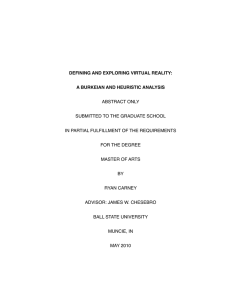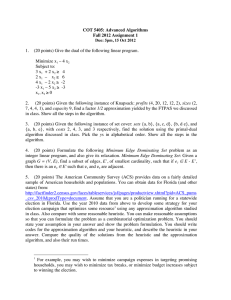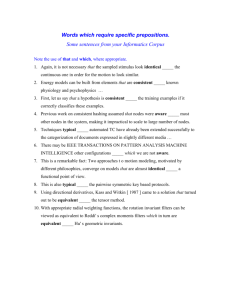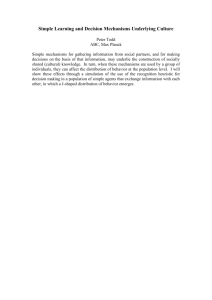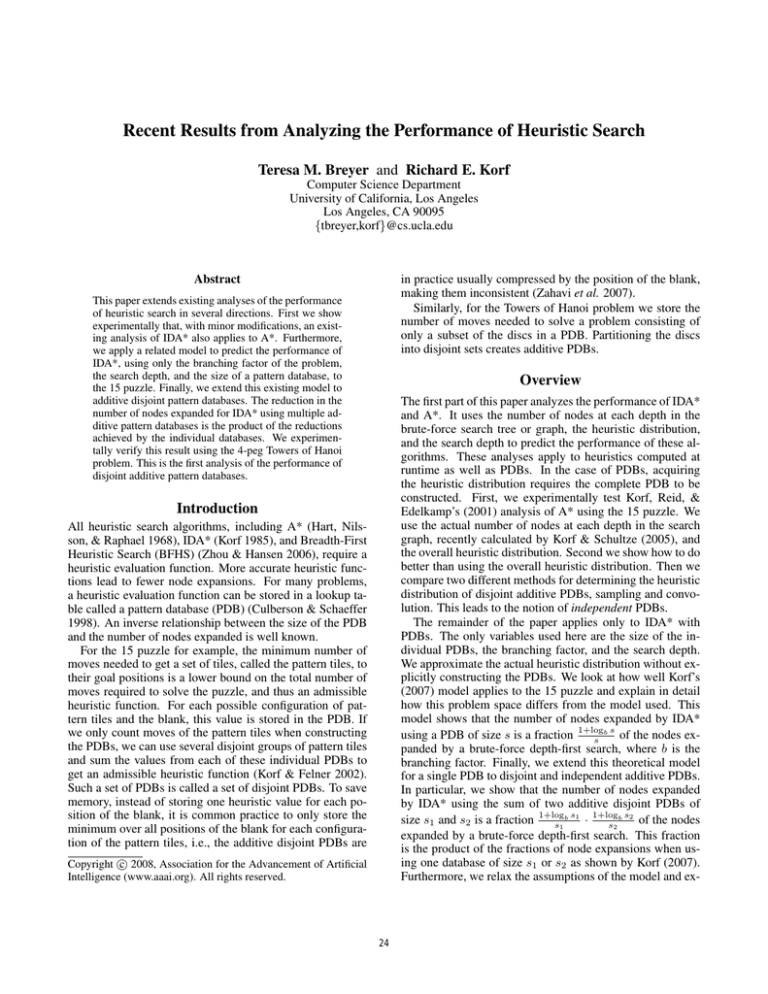
Recent Results from Analyzing the Performance of Heuristic Search
Teresa M. Breyer and Richard E. Korf
Computer Science Department
University of California, Los Angeles
Los Angeles, CA 90095
{tbreyer,korf}@cs.ucla.edu
Abstract
in practice usually compressed by the position of the blank,
making them inconsistent (Zahavi et al. 2007).
Similarly, for the Towers of Hanoi problem we store the
number of moves needed to solve a problem consisting of
only a subset of the discs in a PDB. Partitioning the discs
into disjoint sets creates additive PDBs.
This paper extends existing analyses of the performance
of heuristic search in several directions. First we show
experimentally that, with minor modifications, an existing analysis of IDA* also applies to A*. Furthermore,
we apply a related model to predict the performance of
IDA*, using only the branching factor of the problem,
the search depth, and the size of a pattern database, to
the 15 puzzle. Finally, we extend this existing model to
additive disjoint pattern databases. The reduction in the
number of nodes expanded for IDA* using multiple additive pattern databases is the product of the reductions
achieved by the individual databases. We experimentally verify this result using the 4-peg Towers of Hanoi
problem. This is the first analysis of the performance of
disjoint additive pattern databases.
Overview
The first part of this paper analyzes the performance of IDA*
and A*. It uses the number of nodes at each depth in the
brute-force search tree or graph, the heuristic distribution,
and the search depth to predict the performance of these algorithms. These analyses apply to heuristics computed at
runtime as well as PDBs. In the case of PDBs, acquiring
the heuristic distribution requires the complete PDB to be
constructed. First, we experimentally test Korf, Reid, &
Edelkamp’s (2001) analysis of A* using the 15 puzzle. We
use the actual number of nodes at each depth in the search
graph, recently calculated by Korf & Schultze (2005), and
the overall heuristic distribution. Second we show how to do
better than using the overall heuristic distribution. Then we
compare two different methods for determining the heuristic
distribution of disjoint additive PDBs, sampling and convolution. This leads to the notion of independent PDBs.
The remainder of the paper applies only to IDA* with
PDBs. The only variables used here are the size of the individual PDBs, the branching factor, and the search depth.
We approximate the actual heuristic distribution without explicitly constructing the PDBs. We look at how well Korf’s
(2007) model applies to the 15 puzzle and explain in detail
how this problem space differs from the model used. This
model shows that the number of nodes expanded by IDA*
bs
using a PDB of size s is a fraction 1+log
of the nodes exs
panded by a brute-force depth-first search, where b is the
branching factor. Finally, we extend this theoretical model
for a single PDB to disjoint and independent additive PDBs.
In particular, we show that the number of nodes expanded
by IDA* using the sum of two additive disjoint PDBs of
b s1
b s2
size s1 and s2 is a fraction 1+log
· 1+log
of the nodes
s1
s2
expanded by a brute-force depth-first search. This fraction
is the product of the fractions of node expansions when using one database of size s1 or s2 as shown by Korf (2007).
Furthermore, we relax the assumptions of the model and ex-
Introduction
All heuristic search algorithms, including A* (Hart, Nilsson, & Raphael 1968), IDA* (Korf 1985), and Breadth-First
Heuristic Search (BFHS) (Zhou & Hansen 2006), require a
heuristic evaluation function. More accurate heuristic functions lead to fewer node expansions. For many problems,
a heuristic evaluation function can be stored in a lookup table called a pattern database (PDB) (Culberson & Schaeffer
1998). An inverse relationship between the size of the PDB
and the number of nodes expanded is well known.
For the 15 puzzle for example, the minimum number of
moves needed to get a set of tiles, called the pattern tiles, to
their goal positions is a lower bound on the total number of
moves required to solve the puzzle, and thus an admissible
heuristic function. For each possible configuration of pattern tiles and the blank, this value is stored in the PDB. If
we only count moves of the pattern tiles when constructing
the PDBs, we can use several disjoint groups of pattern tiles
and sum the values from each of these individual PDBs to
get an admissible heuristic function (Korf & Felner 2002).
Such a set of PDBs is called a set of disjoint PDBs. To save
memory, instead of storing one heuristic value for each position of the blank, it is common practice to only store the
minimum over all positions of the blank for each configuration of the pattern tiles, i.e., the additive disjoint PDBs are
c 2008, Association for the Advancement of Artificial
Copyright Intelligence (www.aaai.org). All rights reserved.
24
Depth
40
41
42
43
44
45
46
47
48
49
50
Theoretical
11,866
22,605
42,777
80,392
150,010
277,875
510,850
931,867
1,686,253
3,026,192
5,384,745
Problems
100,000
100,000
100,000
100,000
100,000
100,000
100,000
100,000
14,568
6,137
865
Experimental
11,529
22,340
41,538
79,335
145,661
273,903
496,246
917,729
1,688,045
2,927,342
5,139,035
Error
2.919%
1.188%
2.983%
1.332%
2.986%
1.450%
2.943%
1.540%
0.106%
3.377%
4.781%
Depth
40
41
42
43
44
45
46
47
48
49
50
Theoretical
146
282
544
1,043
1,985
3,756
7,064
13,199
24,506
45,204
82,833
Experimental
136
273
502
994
1,822
3,551
6,469
12,421
22,450
42,448
76,037
Error
7.120%
3.473%
8.447%
4.908%
8.962%
5.784%
9.191%
6.263%
9.159%
6.493%
8.937%
Table 1: Nodes expanded by A* on 15 puzzle using Manhattan Distance
Table 2: Nodes expanded by A* on 15 puzzle using 7-8 tile
pattern database
perimentally verify a slightly more general result using the
4-peg Towers of Hanoi problem.
in this paper hold on average. Usually, one wants to solve
a set of problems, so the average performance is relevant.
These analyses can also be used to choose the best from a
set of heuristics. In equation (1) we substituted the exact
Ñi , which Korf & Schultze (2005) recently calculated for
the 15 puzzle. For P̃ (x), we randomly sampled 10 billion
states.
The experimental results can be seen in Table 1. The first
column gives the search depth. The second column gives the
node expansions predicted by the theoretical analysis. The
third column gives the number of problem instances run. We
randomly created 100,000 initial states with the blank in a
corner, because the start state in Korf & Schultze’s (2005)
Breadth-First Search (BFS) had the blank in a corner as well,
and the Ñi are accurate for all start states with the blank
in a corner. The fourth column gives the average number
of nodes expanded over those initial states. For depths 48
to 50 we ran out of main memory running 100,000 problems despite using BFHS instead of A*, so we stopped at
the first problem that exceeded our main memory. The fifth
column gives the relative error of our analysis. We also used
a state of the art heuristic for the 15 puzzle, the sum of a
7 and an 8-tile disjoint additive PDB, which is inconsistent.
Here BFHS is more efficient than A*, because A* can reopen closed nodes. Again we obtain P̃ by sampling over
10 billion states. Similar to Table 1, Table 2 shows the results over a set of 100,000 random initial states. The error
is slightly larger than in Table 1, because E(N, d, P ) only
gives an upper bound for inconsistent heuristics.
Both experiments show that the predicted number of node
expansions of A* is very accurate. One can notice a systematic disparity between the errors at even and odd depths.
A similar, but slightly smaller effect can be noticed in Korf,
Reid, & Edelkamp’s (2001) experiments on the 15 puzzle
with Manhattan distance and IDA*. There is a simple explanation for this disparity. Manhattan distance and the 7-8 tile
disjoint PDBs both use all tiles. In contrast to non-additive
PDBs for example, where the heuristic estimate h would not
change if a non pattern tile is moved, for Manhattan Distance
and disjoint additive PDBs that use all tiles, each move either increases or decreases h by exactly one move. Since
each move increases the search depth g by one, the f cost
Analyses using Actual Heuristic Distribution
Time Complexity of IDA*
Korf, Reid, & Edelkamp (2001) analyzed the time complexity of IDA*. The number of nodes expanded by IDA* for a
search to depth d is approximately
E(N, d, P ) =
d
X
Ni P (d − i)
(1)
i=0
where Ni is the number of nodes at depth i in the bruteforce search tree, and P is the equilibrium distribution of
the heuristic function. P (x) is the probability that a node
at a given depth chosen randomly and uniformly among all
nodes at that depth has a heuristic estimate less than or equal
to x, in the limit of large depth. The heuristic function is
assumed to be admissible and consistent. This model very
accurately predicts the actual number of nodes expanded by
IDA*. For inconsistent heuristic functions, E(N, d, P ) only
provides an upper bound (Zahavi et al. 2007).
Time Complexity of A*
Korf, Reid, & Edelkamp (2001) suggested that since A* expands each node exactly once, E(N, d, P ) also predicts the
number of nodes expanded by A* when replacing the equilibrium distribution P by the overall heuristic distribution
P̃ . P̃ (x) is the probability that a randomly and uniformly
chosen state has a heuristic value less than or equal to x.
Furthermore, the number of nodes at depth i in the bruteforce search tree Ni is replaced by the number of nodes Ñi
in the problem space graph.
Experimental Results
For our first experiment we ran BFHS on the 15 puzzle with
Manhattan distance. BFHS expands the same set of nodes
as A*, but uses less memory. In all of our experiments we
ignored the goal state and continued the search to the specified depth and our experimental results are averaged over a
large number of random initial states, because all analyses
25
Depth
40
41
42
43
44
45
Theoretical
11,669
22,239
42,095
79,135
147,705
273,692
Experimental
11,529
22,340
41,538
79,335
145,661
273,903
Error
1.218%
0.452%
1.341%
0.252%
1.403%
0.077%
Table 3: Nodes expanded by A* on 15 puzzle using Manhattan Distance, considering the position of the blank
either increases by two or remains the same. Consequently
states with even solution depths always have even f cost,
i.e. the sum of the search depth g and the heuristic estimate
h will always be even. In our experiments states with the
blank in the upper left and lower right corner have even solution depths, while those with the blank in the upper right
and lower left corner have odd solution depths. For an initial state with even solution depth a search to even depth d
expands the same number of nodes as a search to odd depth
d + 1. Consequently, at even depths only the number of
nodes expanded for initial states with even solution depths
increases, and at odd depths the number of nodes expanded
for initial states with odd solution depths increases. We get
two sequences of numbers of node expansions and relative
errors, one is based on states with even solution depths and
one based on states with odd solution depths. If the relative error of the two sequences differs even by a miniscule
amount, the weighted sum over these two sequences exhibits
this disparity between the errors at even and odd depths.
This is the first time that a performance analysis of A*
was verified experimentally. Holte & Hernádvölgyi (2004)
use equation (1) to choose the best among a set of heuristic
functions. They approximate Ni by b̃i where b̃ is the arithmetic average of the actual branching factor of all nodes expanded during the search. But this approximation did not
generate accurate predictions of node expansions.
Depth
Sampling
Convolution
40
41
42
43
44
45
46
47
48
49
50
470
1,001
2,134
4,547
9,688
20,641
43,974
93,684
199,585
425,198
905,843
109
233
496
1,057
2,253
4,802
10,231
21,797
46,438
98,932
210,767
Experimental
444
986
2,040
4,487
9,342
20,397
42,659
92,579
194,331
419,795
883,854
Error
75.5%
76.4%
75.7%
76.4%
75.9%
76.5%
76.0%
76.5%
76.1%
76.4%
76.2%
Table 4: Nodes expanded by IDA* on 15 puzzle using the
7-8 tile pattern database (sampling vs. convolution)
Experimental Results
We reran Korf & Schultze (2005) BFS up to depth 45, keeping track of the number of states with the blank in a corner,
side, and middle position and repeated our experiments on
the 15 puzzle using BFHS and Manhattan distance using the
same 100,000 random initial states. We used three different P̃ , one for each type of state, calculated by sampling
over 10 billion states in total. The small relative error when
using the overall heuristic distribution is reduced by more
than half by using this more accurate set of heuristic distributions. The results are given in Table 3, which is similar to
Table 1, except for a smaller relative error. Again one can
notice a systematic disparity between the errors at even and
odd depths, which we explained above.
Sampling the Heuristic vs. Convolution
In the previous section we used the heuristic distribution
function to analyze the performance of the search algorithm.
Furthermore, sampling was used to obtain the heuristic distribution. When using a PDB, the exact heuristic distribution can be read directly from the database if each state in
the PDB has the same number of pre-images in the original search space (Holte & Hernádvölgyi 2004). For additive
PDBs however, we need the distribution of the sum of the
individual values. The probability distribution of the sum of
two independent random variables is the convolution of their
distributions. The heuristic distributions of the disjoint additive PDBs for the sliding-tile puzzles are correlated however. In the case of the 7 and 8 tile disjoint additive PDBs
for the 15 puzzle, the positions occupied by the 7 pattern
tiles cannot be occupied by any of the 8 pattern tiles. The
convolution however assumes that every state of the 7 tile
pattern space (which is a projection of the original space)
can be combined with every state of the 8 tile pattern space,
to create a state in the original search space.
Experimental results for IDA* on the 15 puzzle with the
7-8 tile disjoint additive PDBs are shown in Table 4. The
first column gives the search depth. The second column
gives the node expansions predicted by equation (1) using
sampling to determine the heuristic distribution. We randomly sampled 10 billion states and differentiated by the po-
Refinement
To further refine the previous estimates, we make a new observation: At shallow levels in the 15 puzzle graph, states
with the blank in the middle are more frequent than states
with the blank in the corner because they have more neighboring states with operators leading to them. The overall
fractions of states with the blank in the corner and states
with the blank in the middle are equal however. Thus at
deep depths, states with the blank in the corner have to become relatively more frequent than states with the blank in
the middle. Korf, Reid, & Edelkamp (2001) showed that
states with the blank in the middle, side, and center have
different overall heuristic distributions. Consequently, the
fractions of each of these three classes of states determine
the heuristic distribution at each depth. We will see a similar
effect in any search space that consists of different classes of
states with different branching factors.
26
& Edelkamp’s (2001) analysis. Ni , the number of nodes at
depth i in the brute-force search tree, is approximated by
bi . Instead of the exact heuristic distribution P , the bruteforce branching factor b and the size s of the PDB are used
to approximate it. The PDB is constructed through a backward breadth-first search from the goal state. The forward
and backward branching factors of the problem space are
assumed to be equal and the graph is assumed to have a negligible number of cycles. In particular, it assumes that there
is one node with heuristic value 0, b nodes with heuristic
value 1, up
bm nodes with maximum heuristic value m,
Pto
m
such that i=0 bi ≥ s. In other words this model only depends on b, s and the search depth d. The heuristic is also
assumed to be consistent. The number of nodes expanded
by IDA* for a search to depth d is approximately
sition of the blank. The third column gives the node expansions predicted when calculating the heuristic distribution
using convolution instead of sampling. Again we differentiated by the position of the blank. The fourth column gives
the average number of nodes expanded over 100,000 random initial states. The last column gives the relative error of
the analysis using convolution compared to the experimental
results in the fourth column.
In Table 4 the analysis using sampling overestimates the
number of nodes expanded slightly. As mentioned earlier
the 7-8 tile disjoint additive PDBs are inconsistent and for
inconsistent heuristic functions equation (1) only gives an
upper bound on node expansions. Mainly the table shows
that the estimate using convolution underestimates the number of node expansions by approximately 75%, even though
it is supposed to be an upper bound. This is because the
convolution underestimates the probabilities of small heuristic values. A very small error in the probabilities of small
heuristic values produces a large error in the predicted node
expansions, because these probabilities are multiplied by the
largest Ni . The probabilities of very large heuristic values are underestimated as well, but they only matter in low
search depths, so they do not introduce significant error.
This observation motivates the following formal definition: A set of additive disjoint PDBs is independent if and
only if the random variables they represent, or equivalently
their heuristic distribution functions, are independent.
In other words, knowing the additive heuristic value of a
state from one PDB does not change the probability of the
heuristic estimates from the remaining disjoint PDBs. Even
though the 7 and 8 tile PDBs are disjoint, i.e., each operator only modifies the values from one PDB, they are not
independent. Examples of independent disjoint PDBs are
the disjoint additive PDBs for the Towers of Hanoi problem.
Once we know which peg a disc is located on, we also know
its position on the peg, because discs are always ordered by
size. A state description consists only of the peg that each
disc is on. Each disc can be assigned to any peg, independent of the locations of all other discs. When we analyze the
performance of disjoint additive PDBs later in this paper we
will take advantage of this property of independence of the
PDBs for the Towers of Hanoi problem.
bd+1 logb s + 1
·
(2)
b−1
s
This formula consists of the number of nodes expanded
by a brute-force search to depth d, multiplied by a reduction
fraction due to the heuristic.
E(b, d, s) ≈
Experimental Results
Korf (2007) showed experimentally that this analysis is accurate for Rubik’s cube. Here we look at another problem
space, the 15 puzzle.
In the 15 puzzle, bd underestimates the number of nodes
in the brute-force search tree at depth d for all three possible
start positions of the blank. This is partly because during
search we do not allow the reverse of the last move, which
reduces the branching factor of each node, except for the initial state, by one. At shallow depths the asymptotic branching factor underestimates the actual branching factor, but
eventually the asymptotic branching factor becomes very accurate. Consequently bi underestimates the number of nodes
at depth i in the brute-force search tree by a factor of ci . If all
states have the same branching factor, the branching factor
converges to the asymptotic branching factor in just a few
depths, such as in Rubik’s cube. In the 15 puzzle convergence takes a bit longer. The branching factor converges to
the asymptotic branching factor as the fractions of the different types of states converge to their equilibrium fractions. As
the branching factor converges to the asymptotic branching
factor b, ci converges to c. Therefore, in our analysis we use
a correction factor c which is numerically fitted so that cbd
accurately approximates the number of states at large depths
d in the brute-force search tree. To be specific we calculated
the weighted average of three different values for c, one for
each type of state depending on the position of the blank,
and get c = 1.499. Using one constant correction factor
initially overestimates the number of nodes at very shallow
depths, even though it is accurate for deep depths, but we
mainly care about the number of nodes at deep depths for
our analysis. Korf (2007) used this correction factor in his
experiments on Rubik’s cube as well.
In the first experiment we use a non-additive 7 tile PDB,
meaning that moves of the 8 non-pattern tiles are counted in
the database values. The numbers of node expansions predicted by Korf’s (2007) model are given in Table 5. The first
Analysis Using Size of a Pattern Database
In the remainder of this paper we analyze the performance of
IDA* using PDBs. The only variables used here are the size
of the individual PDBs, the branching factor, and the search
depth. In the previous section the distribution of the heuristic function was used. In case of PDBs this requires the entire PDB to be constructed. Even sampling random states
to determine the heuristic distribution requires the complete
PDB. In this section we use the size of the PDBs and the
branching factor to approximate the heuristic distribution,
which does not require constructing the complete PDB.
IDA* with a Single Pattern Database
Korf (2007) introduced a model for analyzing the performance of IDA* with a single PDB that builds on Korf, Reid,
27
Depth
40
41
42
43
44
45
46
47
48
49
50
c · E(b, d, s)
2,061,736
4,392,323
9,357,405
19,935,016
42,469,558
90,477,146
192,752,512
410,639,951
874,827,352
1,863,732,191
3,970,495,060
E(N, d, P )
866,152
1,845,251
3,931,124
8,374,864
17,841,820
38,976,963
80,976,963
172,513,352
367,522,400
782,969,525
1,668,038,500
c · E(b, B, d, s)
880,866
1,876,599
3,997,910
8,517,151
18,144,940
38,655,990
82,352,720
175,444,200
373,766,400
796,271,900
1,696,378,000
c · E(b, d, s)
24,880K
53,004K
112,920K
240,565K
512,501K
1,091,831K
2,326,037K
4,955,389K
10,556,962K
22,490,552K
47,913,871K
Depth
40
41
42
43
44
45
46
47
48
49
50
Table 5: Predicted node expansions by IDA* on 15 puzzle
using non-additive 7-tile pattern database
E(N, d, P )
144,485K
307,810K
655,759K
1,397,030K
2,976,232K
6,340,565K
13,507,940K
28,777,315K
61,307,190K
130,608,843K
278,249,050K
c · E(b, B, d, s)
144,477K
307,793K
655,722K
1,396,951K
2,976,064K
6,340,207K
13,507,180K
28,775,690K
61,303,730K
130,601,500K
278,233,400K
Table 6: Predicted node expansions in thousands (K) by
IDA* on 15 puzzle using additive 7-tile pattern database
compressed by the position of the blank
column gives the search depth d. The second column gives
the predicted number of node expansions E(b, d, s) to depth
d based on the size s of the PDB and the branching factor b
multiplied by a correction factor c = 1.499 as explained
above. The next column gives E(N, d, P ) the predicted
number of node expansions using Ni and P . E(N, d, P ) is
within a few percent of the experimental results. Ignore the
last column for now. Clearly the model significantly overestimates the number of nodes expanded.
The underlying model assumes that the branching factors
in the search tree and in the pattern space are equal, and
that there are few cycles. But the pattern space graph of the
15 puzzle has fewer distinguishable nodes than the original
search space, because 8! states of the original search space
are projected onto the same pattern state. Nevertheless the
operators are the same in both spaces. So we encounter a
lot of duplicate states during our breadth-first search backwards from the goal state. Thus we cannot use the bruteforce branching factor b of the original search tree to approximate the breadth-first search used to build the PDB. Instead
we have to use the average branching factor B of the pattern
space graph, which is smaller than b. There are B i nodes
with heuristic value i, not bi . Consequently, Korf’s (2007)
model overestimates the number of nodes with low heuristic
values, which also results in an overestimate of nodes expanded. This is reflected in Table 5.
For the next experiment we look at the 7 tile additive PDB.
Only moves of pattern tiles are counted and we compress the
PDB by the position of the blank.
Similarly to Table 5, Table 6 gives predicted numbers of
node expansions. One can see that the model underestimates
the number of nodes expanded by a significant amount.
For the 7 tile additive PDB one move in the pattern space
is equivalent to a series of moves of non-pattern tiles followed by one move of a pattern tile in the original search
space. Consequently, in the pattern space there are many
more possible moves at a given state and the brute-force
branching factor of the tree expansion of the pattern space
graph becomes much larger than in the original space. On
the other hand 9! states in the original space are projected
onto one state in the pattern space, 8! because of the nonpattern tiles and another 9 because we compress by the po-
sition of the blank. It is not obvious whether the average
branching factor B when searching the pattern space graph
in a breadth-first search will be larger or smaller than the
brute-force branching factor b of the original search space.
The second column of Table 6 shows that the model underestimates the number of nodes expanded as well as the number of nodes with small heuristic values, which implies that
despite the many duplicate nodes B is larger than b.
IDA* with a Single Pattern Database Revisited
The experiments above showed that we have to incorporate
the effective branching factor B of the pattern space graph
in the model. We assume B i nodes with heuristic value i
for i ≤ M , where M is the maximum heuristic value, and
bi nodes at depth i in the brute-force search tree. The probability that a random state has heuristic value x becomes
Px B i
P (x) =
i=0 s . We calculate the maximum heuristic
value M the same way Korf (2007) did:
M
X
Bi
i=0
=1=
s
s(B − 1)
B M +1
⇒ M = logB
(B − 1)s
B
The number of nodes expanded in a search to depth d can be
calculated as
d
d−M
X
X
bi +
bi P (d − i)
E(b, B, d, s) =
i=0
d−M +1
=
b
b−1
+
d
X
i=d−M +1
i=d−M +1
bi
B d−i+1
(B − 1)s
Determining the Effective Branching Factor
To validate this new estimate and to demonstrate that we can
model the distribution of the heuristic function using a single exponential, we have to determine the effective branching factor B. The number of nodes expanded by IDA* in
a search to depth d is estimated by E(b, B, d, s) and multiplied by a correction factor c = 1.499 as explained above.
Except for the effective branching factor of the pattern space
graph B, all variables required are known, but there is no obvious way to determine B without constructing the complete
28
value of PDB j. We calculate mj as follows:
PDB. We calculate B from the actual distribution P as follows. We use a fixed depth d0 , Ni , and P to estimate the
number of nodes expanded to depth d0 , E(N, d0 , P ). Setting c · E(b, B, d0 , s) equal to E(N, d0 , P ) leads to an equation with one unknown, B, and we obtain B by numerically
solving the equation. Alternatively we could have run experiments to a small depth d0 and used that number of node expansions instead of E(N, d0 , P ), or we could have used the
arithmetic average of all the nodes expanded in the breadthfirst search to construct the PDB, similar to how Holte &
Hernádvölgyi (2004) approximated the average branching
factor for A*. All three approaches require the complete
PDB to be constructed though.
The goal here is to verify the model, i.e. to show that the
heuristic distribution can be approximated using a single exponential, and to determine what minimum information is
required to estimate the number of nodes expanded. Only
the distribution for small heuristic values is important, because large heuristic values only matter at low search depths
and only cause a small error in the number of node expansions. Conversely a small error in the estimation of small
heuristic values can create a very large error in the number
of node expansions. Future research focuses on calculating
B cheaply, perhaps by partially constructing the PDB.
mj i
X
b
bmj +1
sj (b − 1)
=1=
⇒ mj = logb
s
(b − 1)sj
b
i=0 j
Cumulative Heuristic Distribution
We assume independence of the individual PDBs. Consequently the distribution of the sum of the two disjoint additive PDBs is the convolution of the distributions of the individual PDBs. A heuristic estimate x has two components,
one from each PDB, x1 and x2 . Equivalently the random
variable X consists of the sum of X1 and X2 . xj always
has to be less than or equal to mj . Thus we have to look at
different ranges for x. First we look at P (x) for x ≤ m1 :
P (x)
= P r[X ≤ x] = P r[X1 + X2 ≤ x]
=
x
X
x−i
X
P r[X1 = i](
P r[X2 = j])
i=0
j=0
For m1 < x ≤ m2 we get:
P (x)
=
m1
X
x−i
X
P r[X1 = i](
P r[X2 = j])
i=0
j=0
Finally we look at P (x) for m1 ≤ m2 < x ≤ m1 + m2 :
Experimental Results
We apply the above described technique to our two examples
from above. We first ran experiments on the 15 puzzle with
the non-additive 7 tile PDB and IDA*. We obtained B =
1.9632 numerically for depth d0 = 40 as described above.
B is smaller than b = 2.1304 as explained previously. The
last column of Table 5 gives the estimated node expansions
E(b, B, d, s) multiplied by the correction factor c = 1.499.
The predicted node expansions is within less than 1% error
of E(N, d, P ), which is known to be accurate, for all depths.
Similarly we determined the effective branching factor
of the compressed additive 7 tile PDB as B = 2.5758 for
depth d0 = 40. The last column of Table 6 gives the estimated node expansions E(b, B, d, s) multiplied by the correction factor c = 1.499. It is within less than 1% of error
of E(N, d, P ) for all depths. Despite the many cycles in
the pattern space, the effective branching factor of the pattern space is larger than the branching factor of the original
search space b = 2.1304 as expected.
Both examples show that the heuristic distribution can be
approximated with a single exponential for low values of h.
P (x)
=
x−m
X2
m2
X
P r[X1 = i](
P r[X2 = j])
i=0
j=0
m1
X
+
x−i
X
P r[X1 = i](
P r[X2 = j])
i=x−m2 +1
j=0
bi
sj
Substituting P r[Xj = i] = and using simple algebraic
transformations, the cumulative heuristic distribution function of the sum of two independent additive PDBs can be
derived as:
x+1
b
(x+1)
if x ≤ m1 ≤ m2
(b−1)s1 s2
bx+1 (m1 +1)
(b−1)s s
if m1 < x ≤ m2
1 2
x+1
x−m2 +1
P (x) =
b
(m
+m
−x)
b
1
2
if m1 ≤ m2 < x
(b−1)s1 +
(b−1)s1 s2
and x ≤ m1 + m2
1
if x > m1 + m2
Number of Nodes Expanded
The number of nodes expanded by IDA* for a search to
depth d using the sum of two additive PDBs of size s1 and
s2 respectively can be predicted as:
IDA* with Additive Disjoint Pattern Databases
Here we extend Korf’s (2007) theoretical analysis for IDA*
to disjoint additive PDBs, i.e., we look at the sum of two independent additive PDBs of size s1 and s2 respectively. We
assume s1 ≤ s2 . The forward and backward branching factors of the problem space are assumed to be b. P r[Xj = x]
where j = {1, 2}, the probability that a random state has
x
a heuristic estimate of x equals bsj . The heuristic distribution function of the individual PDBs are P r[Xj ≤ x] =
Px bi
i=0 sj for x ≤ mj , where mj is the maximum heuristic
E(b, d, s1 , s2 )
=
d−(m1 +m2 )
X
Ni
i=0
d−m
X1
i=d−m2 +1
29
+
d−m
X2
Ni P (d − i) +
i=d−(m1 +m2 )+1
Ni
P (d − i) +
d
X
i=d−m1 +1
Ni P (d − i)
Depth
16
17
18
19
20
21
22
23
24
25
26
27
8 disc PDB
E(N, d, P )
Experimental
142,350
139,850
536,154
526,089
2,019,383
1,979,783
7,605,845
6,797,384
28,646,710
25,763,875
107,895,100
97,582,631
406,376,300
369,362,820
1,530,576,000
5,764,762,000
21,712,400,000
81,777,590,000
308,007,100,000
Error
1.79%
1.91%
2.00%
11.89%
11.19%
10.57%
10.02%
disjoint 8-8 disc PDB
E(N, d, P ) Experimental
Error
6
2
189.97%
22
7
212.05%
82
31
165.40%
310
128
142.09%
1,167
532
119.38%
4,396
2,178
101.83%
16,557
8,840
87.29%
62,359
35,579
75.27%
234,869
142,191
65.18%
884,612
564,685
56.66%
3,331,804
2,230,023
49.41%
12,548,910
8,762,686
43.21%
Conjecture 8-8
Pdisc PDB
k1 k2 · Ni
6
22
82
310
1,167
4,396
16,557
62,359
234,869
884,612
3,331,804
12,548,910
Table 7: Nodes expanded on 16 disc Towers Hanoi using IDA* with a single 8 disc and a disjoint 8-8 disc pattern database
b
f0 (b)
f1 (b)
f2 (b)
2
2
1
0
3
1.464
1.131
0.631
4
1.337
1.126
0.792
5
1.270
1.111
0.861
10
1.140
1.065
0.954
15
1.096
1.046
0.975
Conjecture: Multiplicative Improvement
In most problem spaces the brute-force branching factor is
not equal to the average branching factor in the pattern space
graph. We make a conjecture for these relaxed assumptions:
Given two consistent and independent disjoint additive
PDBs, as well as the fractions k1 and k2 , such that IDA* expands a fraction k1 of the nodes expanded by a brute-force
search when using PDB 1, and a fraction k2 when using PDB
2, then IDA* expands a fraction k1 k2 of the nodes expanded
by a brute-force search when using the sum of the two PDBs.
Table 8: Values of f0 (b), f1 (b), and f2 (b)
So far the formula also holds for dependent additive PDBs.
From here on we require independence though. Plugging in
the distributions and mj from above, bi for Ni , Pascal’s sec
Pm
ond identity k=0 a+k
= a+1+m
and simple algebraic
k
m
transformations yield:
Experimental Results
We used the Towers of Hanoi problem for our experiments.
IDA* is not the algorithm of choice for this problem, because of a large number of duplicate nodes generated during
a depth-first search. But it has the property that the disjoint
additive PDBs are independent. We use the 4-peg 16 disc
problem with a single 8 disc PDB as well as the sum of two
disjoint additive 8 disc PDBs. The initial states are random
configurations of the discs, and the goal state has all discs
on the goal peg.
Table 7 gives experimental results. The first column gives
the search depth d. The next 3 columns have results for a
single 8 disc PDB generated by the 8 smaller discs. The
first column in this block gives E(N, d, P ), the predicted
number of nodes expanded using Ni and P . We approximated the equilibrium distribution P by the overall distribution from the PDB. The second column gives experimental results for the number of nodes expanded averaged over
100,000 random problems above the line, and 10,000 problems below the line. Because of the increasing number of
nodes at each depth, we were not able to complete experiments for all depths. The third column gives the relative
error, which shows that E(N, d, P ) is very accurate, and
consequently P is very close to the overall distribution. The
error appears to increase from depth 18 to 19, but this is because we reduced the number of problem instances run.
The second block uses the sum of two disjoint additive 8
disc PDBs, generated by the smaller and larger 8 discs. The
first column in this block gives E(N, d, P ), where P is calculated as the convolution of the overall distributions of the
bd+1
E(b, d, s1 , s2 ) =
·
(b − 1)s1 s2
b−1 2
b2
b−1
(logb
)
+ logb
(b − 1)2
b
b
b
b−1
b
b−1
+
logb
+ logb s1 (
+ logb
)
b−1
b
b−1
b
b−1
+ logb s2 (logb
+ 1) + logb s1 logb s2
b
Using f0 (b), f1 (b), and f2 (b) as a shortcut for the coefficients of 1, logb s1 , and logb s2 we get:
bd+1
·
(b − 1)s1 s2
(f0 (b) + f1 (b) logb s1 + f2 (b) logb s2 + logb s1 logb s2 )
E(b, d, s1 , s2 ) =
Table 8 shows that f0 (b), f1 (b), and f2 (b) are very close to
1 for larger values of b. Thus, setting them to 1 yields:
bd+1
1 + logb s1 1 + logb s2
·
·
(3)
(b − 1)
s1
s2
This shows that the nodes expanded by IDA* for a search to
b s1
b s2
depth d are a fraction 1+log
· 1+log
of the nodes exs1
s2
panded by a brute-force search. This fraction is the product
of the fractions of node expansions when using one database
of size s1 or s2 from equation (2) as shown by Korf (2007).
E(b, d, s1 , s2 ) ≈
30
lem space, and the search depth. It assumes that the forward
and backward branching factors are uniform and equal, and
that the disjoint PDBs are consistent and independent. For
this model we showed that the number of nodes expanded
b s1
b s2
by IDA* is a fraction 1+log
· 1+log
of the number of
s1
s2
nodes expanded by a brute-force search. Finally we generalized this result, showing the reduction in the number of
nodes expanded using multiple additive PDBs is the product
of the reductions achieved by the individual databases. If
we can predict the fractions kj for individual PDBs, we can
also predict the performance of the sum of disjoint additive
PDBs. We experimentally verified this result using the Towers of Hanoi problem. This is the first result analyzing the
performance of disjoint additive PDBs.
Currently we are working on bridging the gap in analyzing disjoint additive PDBs for real world problems, i.e., predicting the fractions kj for a single PDB correctly. Furthermore we are trying to extend our analysis from two to n disjoint additive PDBs. We expect that this same analysis will
extend to n PDBs. Also, we have been looking at the performance of A* using disjoint additive PDBs. Future work
includes predicting the performance of A* without knowing
the exact number of nodes at each depth.
two additive PDBs. Since any set of 8 different-sized discs
generates the same PDB (Korf & Felner 2007) we used the
same PDB for the smaller and for the larger 8 discs, and
both have the same overall distributions. The second column gives experimental results averaged over 100,000 random problems for all depths. The third column gives the
relative error. It seems that the experimental results for the
sum of two 8 disc PDBs are very inaccurate, but the error
keeps decreasing as d increases. One major source of error
is introduced when approximating the equilibrium distributions by the overall distributions. Even though both additive PDBs have the same overall distributions, their equilibrium distributions differ. Experiments on smaller problem
instances have shown, that the equilibrium distribution for
the larger discs deviates more from the overall distribution
than the one for the smaller discs. Also, the heuristic distribution for the larger discs converges much slower to the
equilibrium distribution than the one for the smaller discs,
because most moves move one of the smaller discs.
The last column gives the predicted number of nodes expanded using our conjecture, i.e. the nodes in the bruteforce search tree times k1 k
2 . The fractions k1 and k2 are
P
d
calculated as E(N, d, P )/ i=0 Ni or the nodes expanded
by IDA* using one 8 disc PDB from the first block, divided by the number of nodes expanded by a brute-force
search. The reduction fractions k1 and k2 are equal, i.e.
k1 = k2 = 4.0742 · 10−5 , because we used the same overall
distribution for both PDBs. The conjecture predicts the same
number of node expansions as predicted by E(N, d, P ) from
the second block, where P is calculated using the convolution of the distributions of the two additive PDBs. We also
calculated the number of node expansions predicted by the
conjecture for a different number of discs and two PDBs of
different size, and confirmed that it predicts the same number of node expansions as E(N, d, P ) using convolution.
Acknowledgment
This research was supported by NSF Grant IIS-0713178.
References
Culberson, J. C., and Schaeffer, J. 1998. Pattern databases.
Computational Intelligence 14(3):318–334.
Hart, P.; Nilsson, N.; and Raphael, B. 1968. A formal basis for the heuristic determination of minimum cost paths.
IEEE Transactions on Systems Science and Cybernetics
4(2):100–107.
Holte, R. C., and Hernádvölgyi, I. T. 2004. Steps towards
the automatic creation of search heuristics. Technical Report TR04-02, Computing Science Department, University
of Alberta, Edmonton, Alberta.
Korf, R. E., and Felner, A. 2002. Disjoint pattern database
heuristics. Artif. Intell. 134(1-2):9–22.
Korf, R. E., and Felner, A. 2007. Recent progress in heuristic search: A case study of the four-peg towers of hanoi
problem. In IJCAI-07, 2324–2329.
Korf, R. E., and Schultze, P. 2005. Large-scale parallel
breadth-first search. In AAAI-05, 1380–1385.
Korf, R. E.; Reid, M.; and Edelkamp, S. 2001. Time
complexity of iterative-deepening-A*. Artif. Intell. 129(12):199–218.
Korf, R. E. 1985. Iterative-deepening-A*: An optimal
admissible tree search. In IJCAI-85, 1034–1036.
Korf, R. E. 2007. Analyzing the performance of pattern
database heuristics. In AAAI-07, 1164–1170.
Zahavi, U.; Felner, A.; Schaeffer, J.; and Sturtevant, N. R.
2007. Inconsistent heuristics. In AAAI-07, 1211–1216.
Zhou, R., and Hansen, E. A. 2006. Breadth-first heuristic
search. Artif. Intell. 170(4):385–408.
Conclusions and Further Work
We have extended existing analyses of the performance of
heuristic search. The first result was experimentally verifyPd
ing that E(Ñ , d, P̃ ) = i=0 Ñi P̃ (d − i) for A* for the 15
puzzle. We showed that for A*, using the overall distribution
P̃ is only approximate, because nodes with high branching
factors are more likely to be visited at lower depths than
nodes with low branching factors. This fact applies generally, not just for the sliding tile puzzle. We improve our
prediction by using more accurate distributions for different
classes of states, with the fraction of nodes of each class depending on the search depth. We demonstrated such a refinement for the 15 puzzle. These are the first results accurately
predicting actual numbers of node expansions for A*.
Next we looked at how well Korf’s (2007) model for IDA*
applies to the 15 puzzle. We observed that the major discrepancy between the model and this problem is the difference
in the brute-force branching factor of the problem tree and
the branching factor of the pattern space graph.
A further contribution was extending Korf’s (2007) model
to disjoint additive PDBs. This model only uses the size sj
of two additive PDBs, the branching factor b of the prob-
31

